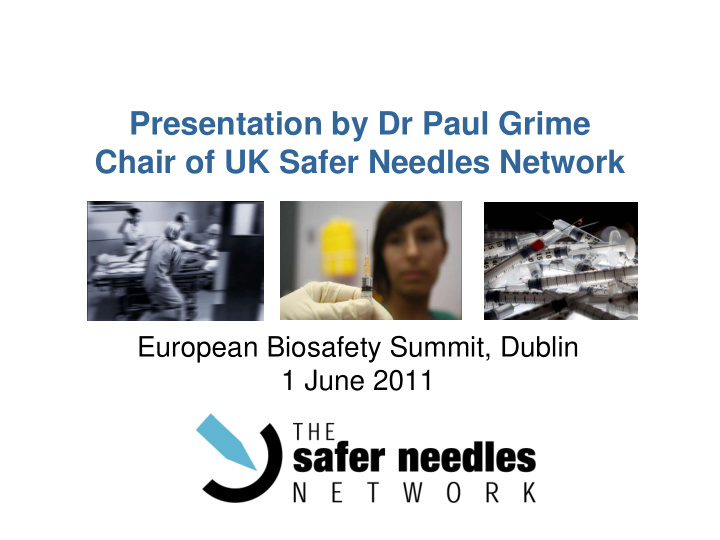



Presentation by Dr Paul Grime Chair of UK Safer Needles Network European Biosafety Summit, Dublin 1 June 2011
Safer Needles Network UK The Safer Needles Network is made up of trade unions, professional organisations, clinicians, government agencies and manufacturers The Network aims to eliminate sharps injuries The Network promotes: • Standard universal precautions • Provision of safety engineered devices • Safe disposal of sharps • Education and training
Information, lobbying and awareness raising • Coalition building, informing and influencing decision makers and stakeholders • Media activity and awareness raising of the risks by demonstrating impact of sharps injuries • Maintaining relationship with employers to implement guidance, regulators to ensure compliance and political campaigning to provide legislative and statutory protection • Dissemination of information and best practice through websites, emails and workshops • Encouragement and facilitation of reporting and surveillance systems
Risk Management and Prevention • Eliminate risk – unnecessary use of sharps • Engineering controls – medical devices with safety engineered protection mechanism • Safe systems of work - effective working procedures, training and disposal and ban on recapping • PPE – personal protective equipment • Vaccination • Well resourced and organised workforce • Reporting • Surveillance systems
Business Case • Competing priorities mean that any proposal for change must be robust and persuasive to secure success • Safer systems of work include data recording, regular education and training and provision of medical devices • Cost considerations can discourage employers to invest to protect staff and patients • Savings can be made on claims for clinical negligence, usage patterns, discounts, reduction in rate of exposure incidents • Legislation and regulations compel employers to protect staff and patients • Costs of not implementing are likely to be greater in the long term if safer systems of work are not introduced in the short term
Introduction of safety-engineered devices • Managers should consult with worker representatives on the choice and uses of safety-engineered devices • Workers need to be involved in any costing data and procurement decisions • Comprehensive user training is pivotal to the successful introduction of safety devices • Implementation of safer systems of work is more effective when safety devices, training and safer working procedures are introduced in combination • The following table summarises the blood exposure risks relative to the use of different types of medical devices:
Risk assessment matrix Ref. Prof A Wittman, University of Heidelberg, May 2011
Directive and Toolkit for Implementation • The Directive must be implemented in all Member States by 11 May 2013 • The EBN Implementation Guidance was published to assist employers and workers to prepare for implementation before the deadline – in the UK NHS Employers published parallel implementation guidance in 2010 • Legislation is the most effective route to ensuring that the new requirements of the Directive are implemented – in the UK the Directive will be transposed direct into Statute by 2013 • The EBN Toolkit for Implementation gives practical advice on the measures necessary for effective implementation of the Sharps Directive
www.saferneedles.org.uk/
Recommend
More recommend